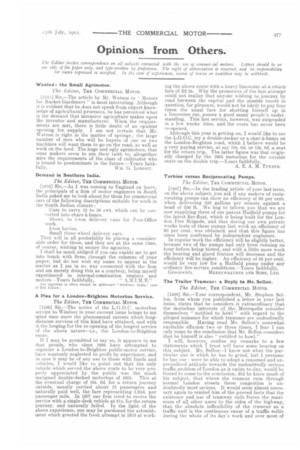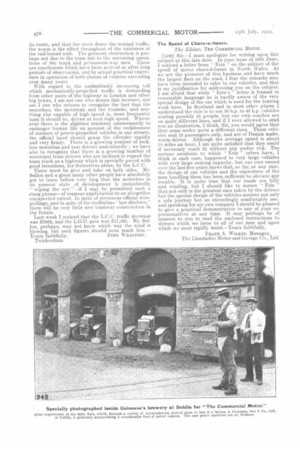Opinions from Others.
Page 17

Page 18

If you've noticed an error in this article please click here to report it so we can fix it.
The Editor invites correspondence on all subjects connected with the use of commerzial motors. Letters should be on
one side of the paper only, and type-written by preference. The right of abbreviation is reserved, and no responsibility for views expressed is accepted. In Me case of experiences, names of towns or localities may be withheld.
Wanted : the Small Agritnotor.
The Editor, THE COMMERCIAL MOTOR.
[15S1] Sir,—The article by Mr. Watson re " Motors for Market Gardeners "is most interesting. Although it is evident that he does not speak from expert knowledge of agricultural processes, he has perceived what is the demand that intensive agriculture makes upon the inventor and manufacturer. When the requirements are met, there is little doubt of an opulent opening for supply. I am not certain that Mr. Watson is right in the matter of springs ; the large number of men who will be buyers of one or two machines will want them to go on the road, as well as work on the land. The huge and ugly agrimotors, that some makers seem to pin their faith to, altogether miss the requirements of the class of cultivator who is bound to predominate in the future.—Yours faith
fully, Wm. G. LOBJOIT.
Demand in Southern India.
The Editor, THE COMMERCIAL MOTOR.
[1585] Sir,—As I was corning to England on leave, the principals of a firm of motor engineers in South India asked me to look about for them for commercial cars of the following descriptions suitable for work in the South Indian climate :
Cars to carry 12 to 30 cwt. which can be converted into chars-a.-banes.
10-cwt. to 1-ton delivery vans for Post-Office work.
2-ton lorries.
Small three-wheel delivery cars.
They will in all probability be placing a considerable order for these, and they are at the same time, of course, wishing to secure the agencies. I shall be much obliged if you can enable me to get into touch with firms through the columns of your paper, but do not wish my name to appear in the matter as I am in no way connected with the firm and am merely doing this as a courtesy, being myself experienced in internal-combustion engines and motors.—Yours faithfully, " A.M.I.M.E."
Any inquiries or offers should be addressed "Southern India," care of The Editor.] A Plea for a London-Brighton Motorbus Service.
The Editor, Tss COMMERCIAL MOTOR.
[1586] Sir,—The notice of the L.G.O.C. motorbus service to Windsor in your current issue brings to my mind once more the phenomenal success which longdistance services of this kind have attained, and with it the longing for the re-opening of the longest service of the above nature—i.e., the London-to-Brighton route.
If I may be permitted to say so, it appears to me that people, who since 1905 have attempted to organize a London-to-Brighton public-motor service, have wantonly neglected to profit by experience, and in ease it may be of any use to those with funds and vehicles, I would like to point out that the only vehicle which served the above route to be very properly appreciated by the public was the much maligned double-decked motorbus of 1905. This at the eventual charge of 10s. 6d. for a return journey outside, usually carried about 18 passengers and naturally paid well, the fare representing 1.23d. per passenger mile. In 1907 one firm tried to revive the service with a single-deck vehicle at 21s. for the return journey, and naturally failed. In the light of the above experience, one may be pardoned the astonishment which greeted the fresh attempt in 1910 at work
ing the above route with a heavy limousine at a return fare of 22 2s. Why the promoters of the last attempt could not realize that anyone wishing to journey by road between the capital and the seaside resort in question, for pleasure, would not be likely to pay four times the usual fare for shutting himself up in a limousine car, passes a good many people's understanding. This last service, however, was suspended in a few weeks' time, and the route has never been re-opened.
Although this year is getting on, I would like to see the L.G.O.C. try a double-decker or a char-à-bancs on the London-Brighton road, which I believe would be a very paying service, at say 10s. 6d. or 12s. 6d. a seat for the return trip_ The latter figure was that originally charged by the 1905 motorbus for the outside seats on the double trip.—Yours faithfully,
A. E. A. M. TURNER.
Turbine versus Reciprocating Pumps.
The Editor, THE COMMERCIAL MOTOR.
[1587] Sir,—In the leading article of your last issue, on the above subject, you ask if any makers of reciprocating pumps can show an efficiency of 68 per cent. when delivering 630 gallons per minute against a head of 250 ft. We beg to inform you that we are now supplying three of our patent Hatfield pumps for the latest fire-float, which is being built for the London Fire Brigade, and that during our own private works tests of these pumps last week an efficiency of 90 per cent.. was obtained, and that this figure has since been confirmed by independent engineers. In regular work the efficiency will be slightly better, because two of the pumps had only been running an hour before being tested, and with a little more work the bearing and gland friction will decrease and the efficiency will be higher. An efficiency of 68 per cent. would be very low for a Hatfield pump under any ordinary fire-service conditions.—Yours faithfully,
Greenwich. MERRYWEATHER AND SONS, LTD.
The Trailer Tramcar: a Reply to Mr. Sellon.
The Editor, THE COMMERCIAL MOTOR.
115881 Sir,—Your correspondent, Mr. Stephen SeIon, from whom you published a letter in your last issue, states that he considers it extraordinary that the motorbus interests of the Metropolis consider themselves "entitled to hoswl " with regard to the alleged nuisance for which tramcars are undoubtedly responsible. Having read Mr. Sellon's somewhat excitable effusion two or three times, I fear I can only come to the conclusion that Mr. Sellon considers that he himself is also " entitled to howl."
I will, however, confine my remarks to a few statements which I trust will have some bearing on this subject. Mr. Sellon—I know not what the particular axe is which he has to grind, but I presume he has one were he able to adopt a reasoned and unprejudiced attitude towards the undoubtedly serious traffic problem of London as it exists to-day, would be forced to come to the conclusion, did he know much of his subject, that where the tramcar runs through normal London streets there congestion is undoubtedly most serious. It would seem almost necessary again to remind him of the proved facts that the existence and use of tramway rails forces the maximum of all other users to the sides of the highway, that the absolute inflexibility of the tramcar as a traffic unit is the continuous cause of a traffic me/de during the whole of its day's work and over most of
its route, and that the more dense the normal traffic, the worse is the effect throughout of the existence ot the rail-bound unit. The greatest obstruction is perhaps not due to the tram but to the unceasing operations of the track and permanent-way men. These are conclusions which have been arrived at after long periods of observation, and by actual practical experience in operation of both classes of vehicles extending over many years.
With regard to the undoubtedly increasing toll which mechanically-propelled traffic is demanding from other users of the highway in London and other big towns, I am not one who denies this increase, nor am I one who refuses to recognize the fact that the motorbus, the motorcab and the tramcar, and anything else capable of high speed is, more frequently tuan it should be, driven at such high speed. Whereever there is the slightest tendency unnecessarily to endanger human life on account of the recklessness of conduct of power-propelled vehicles in our streets, the official hand should grasp the offender rapidly and very firmly. There is a growing number of reckless motorbus and taxi drivers undoubtedly ; we have also to recognize that there is a growing number of municipal tram drivers who are inclined to regard the tram track as a highway which is specially paved with good intentions, for themselves alone, by the L.C.C.
There must be give and take on both sides. Mr. Sellon and a great many other people have absolutely got to learn before very long that the motorbus in its present state of development is undoubtedly "wiping the eye "—if I may be permitted such a slang phrase—of tramcar exploitation to an altogether unexpected extent. In spite of strenuous official wirepullings, and in spite of the trolleybus "last ditchers,' there will be very little new tramway construction in the future.
Last week I noticed that the L.C.C. traffic decrease was 23862, and the L.G.O. gain was £17,565, Mr. Sellon, perhaps, may not know which way the wind is blowing, hut such figures should soon teach him.—
Yours faithfully, Joirx WHALEBBY. Twickenham. The Speed of Chars-a-banes.
The Editor, THE COMMERCIAL MOTOR.
[1589] Sir,—I must apologize for writing upon this subject at this late date. In your issue ot 13th June, I noticed a letter from Erin" on the subject of the speed of motor chars-ii-bancs in North Wales. As we are the pioneers of this business and have much the largest fleet on the road, I fear the remarks may have been intended to refer to our vehicles, and that is my justification for addressing you on the subject. I am afraid that while " Erin's "letter is framed in reasonable language he is hardly aware of the very special design of the car which. is used for the touring work here. In Scotland and in most other places I understand the rule is to use 30 h.p. to 40 h.p. vehicles seating possibly 35 people, but our own coaches are on quite different lines, and if I were allowed to send you an illustration, I think, Sir, you would agree that they come under quite a different class. These vehicles seat 18 passengers only, and are of Dennis make, worm-driven. Although the average speed is about 18 miles an hour, I am quite satisfied that they could if necessary reach 25 without any undue risk. The serious accidents to which " Erin " .refers have, I think in each case, happened to very large vehicles with very large seating capacity, but our own record over the last five years shows that, so far, at any rate, the design of our vehicles and the experience of the men handling them has been sufficient to obviate any trouble. It is quite true that our roads are hilly and winding, but I should like to assure " Erin " that not only is the greatest care taken by the drivers but the special design of the vehicles assures not only a safe journey but an exceedingly comfortable one, and speaking for my own company I should be pleased to give a practical demonstration to any of your representatives at any time. It may perhaps be of interest to you to read the enclosed instructions to drivers which we issue to all of our men and upon which we most rigidly insist —Yours faithfully, FRANK A. Wilaus, Manager, The Llandudno Motor and Garage Co., Ltd.






















